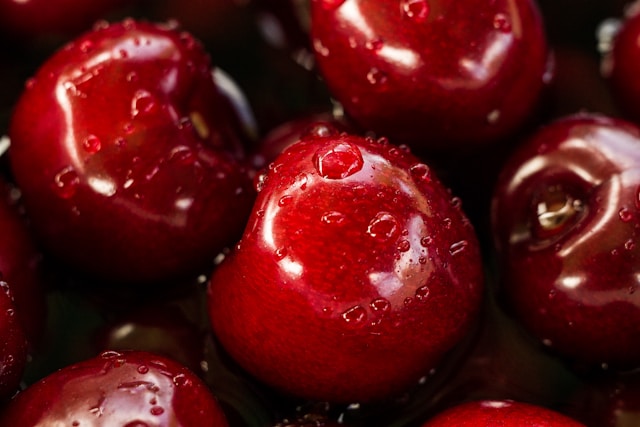Tips on picking, pitting, and storing fresh cherries straight from the farm.
Cherry season is oh-so-short, and oh-so-sweet. Living in New England, where fresh cherries are a seasonal rarity, I find myself eagerly scooping up every last one whenever they appear at the farmers' market and local grocery stores.
Because cherry season is so short, being in the right place at the right time and knowing how to maximize life span is pivotal. Patience is not my strongest skill, so I decided to get a head start on the cherry season.
While visiting family in Northern California this past week, I made a run to Chinchiolo Farm in Lodi, to see the operations (and fill my basket and belly). With over 40 acres of cherry trees, James Chinchiolo, a fourth-generation cherry farmer and owner of Lodi Blooms, is the guy to listen to for all things cherries. Here's what he had to share about storing and pitting cherries.
How to store cherries
According to Chinchiolo, choosing the right place to store your cherries depends on where and how you buy them. At the farm, workers pick cherries early in the morning before sunrise at cooler temperatures, all by hand, to ensure the fruit tastes as good as the moment it was picked from the tree, and to keep the temperature of the fruit cool.
Cool down cherries from the farm
If you're one of the lucky ones who lives near a cherry farm, Chinchiolo has a tip for keeping them fresh. He says, "If you're picking the cherries in the orchard or you buy them warm at a fruit stand, take them home and put them in a colander. Put the colander into a pot with ice water and get the temperature of the cherries as low as possible. This is an advanced move, as you're basically making a hydro cooler to cool them down as quickly as possible." Keeping them in the colander means as soon as they’re cool, you can lift up the colander and drain the cool cherries. “Chilling your freshly picked cherries should keep the skin nice and tight and avoid any unwanted mealiness,” he says.
Keep grocery store cherries in the bag
"If you buy your cherries at a grocery store, they will most likely come in a plastic bag with holes or in a clamshell. If that's the case, continue to store them in that," says Chinchiolo. "You want to make sure you keep the cherries from going anaerobic, which basically means fermenting. The cherries are still metabolizing and if they get sealed in a bag without oxygen, they may get mealy and have a much shorter lifespan."
Another way to get farm-fresh cherries is to order directly to your door online during peak cherry season, thanks to the modern-day magic of cold packing. I saw the heavy machinery and power that goes into shipping cherries cold across the country at Chinchiolo Farms, and it's no joke. Two-day shipping had cherries on my parents' doorstep in Massachusetts days after picking, fresh and ready to enjoy (daughter of the year award goes to me!).
Regardless of the method, it's crucial to keep cherries cool, with the ideal temperature being 33°F, as advised by Chinchiolo. He suggests placing them at the back of the fridge for the coolest conditions.
Frequently Asked Questions
When are cherries in season?
Though it varies depending on the variety, cherries are in season in the U.S. from about May through July. Look for shiny and firm cherries that are a deep red, with green stems.
How long do cherries last?
If stored properly, cherries will last in the fridge for at least a week.
How to pit cherries
In peak cherry season, nothing will stop me from baking with cherries — but pitting them individually by the masses can feel like a Sisyphean task. However, with or without a pitter, there are easy ways to remove pits from your cherries.
If you're freezing your cherries, Chinchiolo cautions, "Pit ahead of time for freezing. If you freeze your cherries with the pit, you just about need to be a surgeon to get the pit out."
If you’re only working with a few cherries, try this trick I learned on TikTok. First, remove the stem. Then, using either a chopstick or a metal straw, pierce the skin with the straw where the stem used to be and push the pit straight through the fruit and out the other side. You can also use a chopstick, though I prefer a straw, as I find that it catches the pit more easily.
Another sneaky trick involves a paperclip. Remove the stem of the cherry, bend the paperclip once (so there is only one loop), pierce the cherry where the stem was, and rotate the paperclip around the pit, scooping it out where the clip entered into the fruit.
Baking with cherries demands calling in the big guns, aka the Quick-Release Multi Cherry Pitter from OXO. And she's not a one-trick pony; this multi-pitter is also effective at removing olive pits. Able to pit six cherries at a time, this tool is worthwhile if you're baking or making a fruit salad, or if you are an avid cherry consumer. OXO also makes a single cherry pitter that pits cherries of all sizes quickly and effortlessly, but you might as well get the big one as it goes so much faster.
This article was written by Rachel Levin from Food & Wine and was legally licensed through the DiveMarketplace by Industry Dive. Please direct all licensing questions to legal@industrydive.com.








